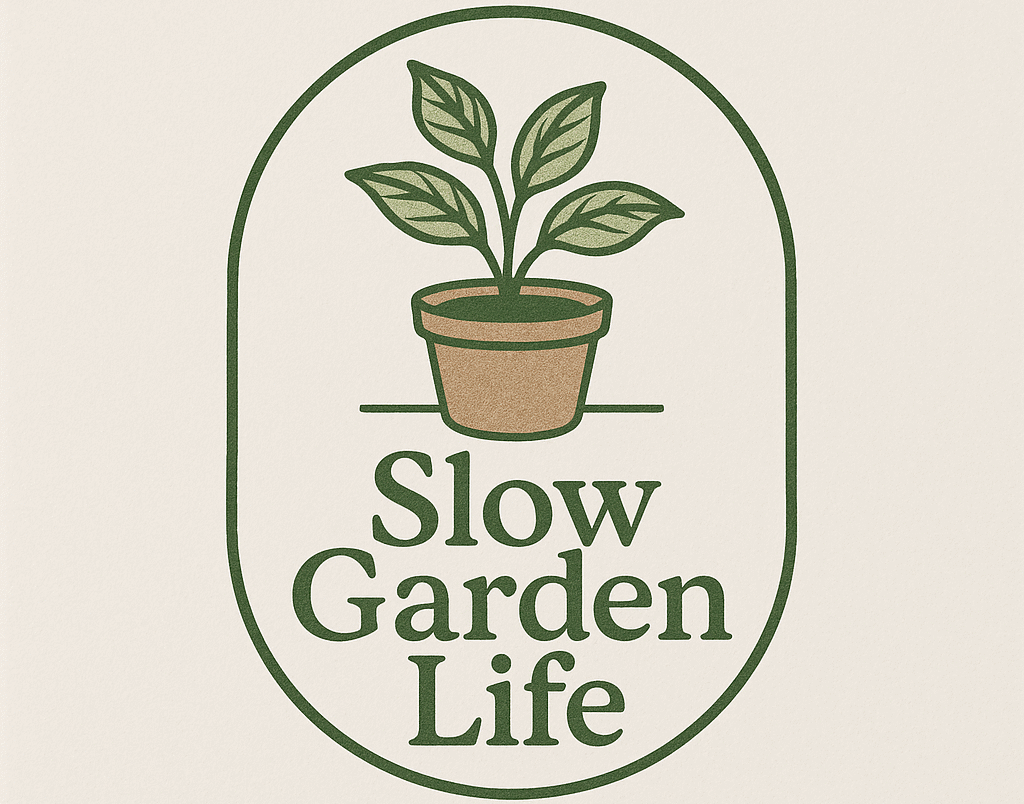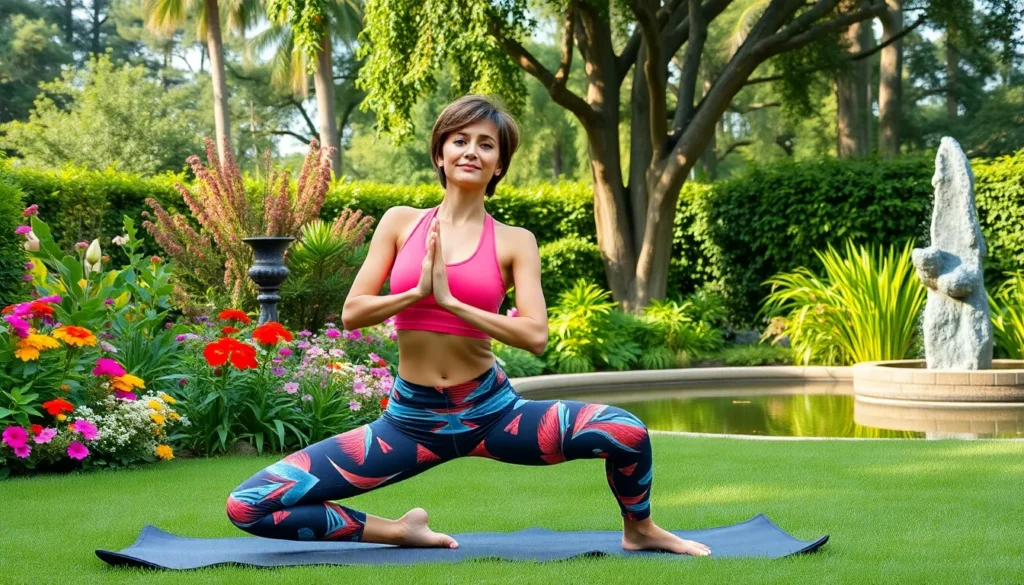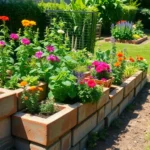We’ve all dreamed of having our own personal fitness space that doesn’t require a crowded gym membership or expensive indoor equipment. Creating a garden gym transforms your outdoor space into the ultimate workout sanctuary where fresh air meets fitness goals.
Your backyard holds incredible potential for becoming a versatile exercise haven that’ll make you actually look forward to working out. From simple bodyweight stations to full outdoor gym setups we’ll show you how to maximize every square foot of your garden space. Whether you’re working with a compact patio or sprawling lawn there’s a perfect garden gym solution waiting for you.
The best part? You’ll save money on gym memberships while building a fitness space that’s available 24/7 right outside your door. We’re about to share game-changing garden gym ideas that’ll revolutionize how you think about outdoor fitness and help you create the backyard workout paradise you’ve always wanted.
Transform Your Shed Into a Complete Fitness Studio
Converting your existing shed into a dedicated fitness studio offers the perfect solution for year-round garden gym workouts. We’ll show you how to maximize this underutilized space for your home fitness goals.
Convert Storage Space to Workout Haven
Clear out unnecessary items first to assess your shed’s true potential. Most standard sheds provide 64 to 120 square feet of floor space, which accommodates multiple workout zones including cardio, strength training, and stretching areas.
Level the flooring using interlocking foam tiles or rubber mats to create a stable exercise surface. These materials cost between $2 to $5 per square foot and provide cushioning for high-impact activities like jumping jacks or burpees.
Paint the interior walls with light colors such as white or pale yellow to make the space feel larger and more inviting. Light colors reflect available light and create an energizing atmosphere for your garden gym sessions.
Install wall-mounted mirrors along one or two walls to check your form during exercises. Mirrors measuring 36 by 48 inches cost approximately $40 to $80 each and make your shed studio feel twice as spacious.
Install Proper Ventilation and Lighting
Add ventilation fans to maintain air circulation during intense workouts. Install at least two exhaust fans with 150 CFM capacity each to prevent moisture buildup and ensure comfortable temperatures.
Install LED strip lighting around the perimeter of your ceiling to provide bright, even illumination. LED strips consume 80% less energy than traditional bulbs and produce minimal heat in your enclosed garden gym space.
Create natural light sources by adding windows or skylights if your shed structure allows. Natural light improves mood and reduces eye strain during morning or afternoon workout sessions.
Connect electrical outlets every 6 feet along the walls to power equipment like treadmills, speakers, or charging stations for fitness trackers and phones.
Add Essential Equipment Storage Answers
Mount wall racks for storing free weights, resistance bands, and yoga mats vertically. Wall storage systems maximize floor space while keeping equipment organized and easily accessible.
Install ceiling hooks for suspension trainers, punching bags, or resistance equipment. Ceiling hooks rated for 200 pounds or more provide secure mounting points without consuming valuable floor area.
Build corner shelving units using basic lumber to house smaller items like water bottles, towels, and workout accessories. Corner shelves use dead space effectively in your garden gym studio.
Add lockable storage cabinets to protect valuable equipment from moisture and temperature fluctuations. Metal cabinets with weather sealing preserve electronics and prevent rust on metal components.
Create a Dedicated Outdoor Weightlifting Area
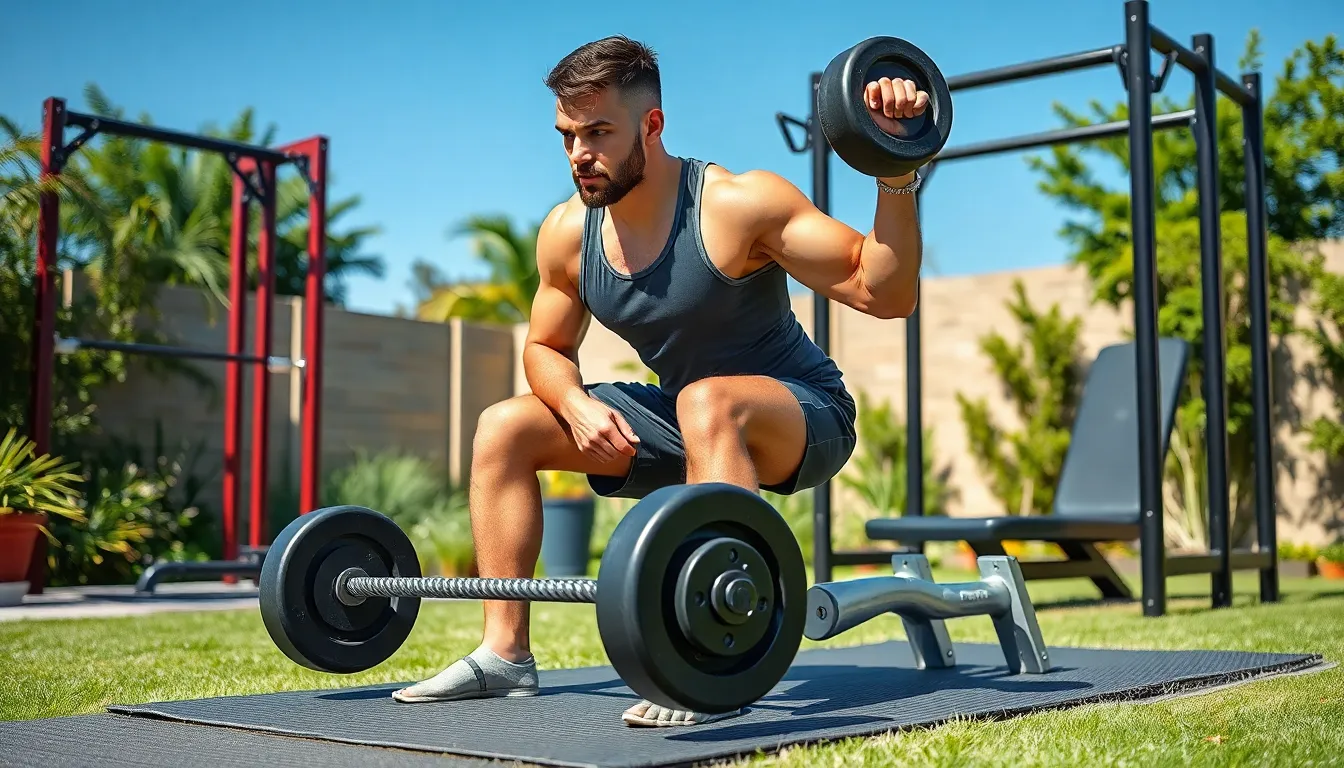
We’ll transform your garden space into a serious strength training zone that rivals any indoor gym. Planning a dedicated weightlifting area requires strategic placement and smart equipment choices to maximize both safety and performance.
Choose Weather-Resistant Equipment Options
Galvanized steel pull-up frames resist rust and corrosion while providing years of reliable use outdoors. We recommend constructing these frames using thick-gauge steel pipes that can support heavy loads without compromising structural integrity.
Outdoor fitness benches made from powder-coated steel or marine-grade aluminum offer superior durability against moisture and temperature fluctuations. These materials maintain their strength even after prolonged exposure to rain, snow, and UV rays.
Resistance bands provide versatile training options without the maintenance concerns of metal weights. Commercial-grade latex bands withstand outdoor conditions better than cheaper alternatives and offer consistent resistance across temperature ranges.
Wooden beam pull-up bars create a natural aesthetic while delivering exceptional strength when properly treated with weather-resistant sealants. Cedar and pressure-treated lumber resist decay and insect damage effectively.
Install Proper Flooring for Heavy Lifting
Rubber mat systems provide the foundation for safe heavy lifting by absorbing impact and preventing equipment damage. We suggest installing interlocking rubber tiles that create a stable, non-slip surface capable of handling dropped weights.
Multipurpose lifting platforms constructed from plywood topped with rubber mats offer professional-grade performance at home. These platforms distribute weight evenly and protect both your equipment and the ground beneath.
Drainage considerations become critical when installing permanent flooring systems outdoors. Proper slope and perforated materials prevent water accumulation that could compromise your lifting surface over time.
Thickness matters when selecting rubber flooring, with 3/4-inch mats providing optimal protection for heavy deadlifts and Olympic lifts. Thinner options work well for bodyweight exercises but lack the cushioning needed for serious weightlifting.
Design Effective Equipment Protection Systems
Waterproof storage benches serve dual purposes by providing seating during workouts while protecting weights and accessories from the elements. We recommend building these with marine-grade plywood and weatherproof hinges.
Equipment covers made from heavy-duty vinyl or canvas protect exposed gear during storms and winter months. Custom-fitted covers last longer than generic options and provide better protection against moisture infiltration.
Ventilated storage answers prevent rust and corrosion by allowing air circulation around metal equipment. Slatted designs or perforated panels maintain protection while reducing moisture buildup inside storage areas.
Lockable cabinets secure valuable equipment while keeping it accessible for daily workouts. Stainless steel hardware and weatherproof seals ensure these storage systems function reliably in all conditions.
Build a Functional Bodyweight Training Zone
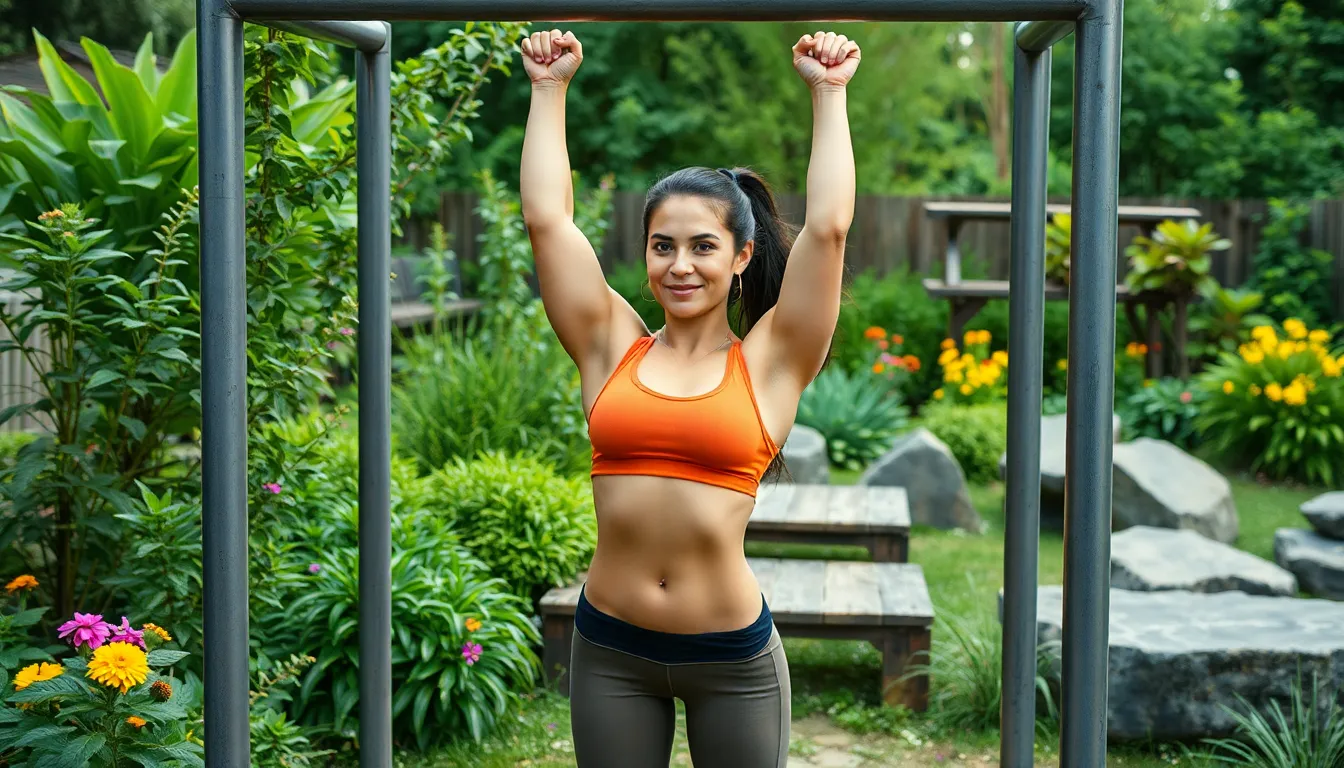
Bodyweight training transforms any garden space into a versatile fitness zone that supports natural movement patterns like pushing, pulling, squatting, and lunging. We’ll create a dedicated area that maximizes your outdoor workout potential while maintaining the natural beauty of your garden.
Set Up Pull-Up Bars and Suspension Systems
Pull-up bars form the foundation of upper body strength training in our bodyweight zone. Installing a galvanized steel frame provides the robust structure needed to accommodate various body weights and movement intensities safely.
Wall-mounted options work perfectly for garden walls or shed exteriors, while freestanding frames offer flexibility in placement. We recommend positioning these systems on level ground with adequate overhead clearance for ever-changing movements.
Suspension systems like TRX or gymnastic rings expand our exercise possibilities dramatically. These versatile tools attach to pull-up bars or sturdy tree branches, enabling full-body workouts that challenge stability and strength simultaneously.
Consider installing multiple anchor points at different heights to accommodate various exercises and user preferences. Weather-resistant materials ensure year-round functionality without compromising safety or performance.
Create Multi-Level Platform Areas
Multi-level platforms add vertical dimension to our bodyweight training zone through strategic height variations. Low steps ranging from 6 to 12 inches provide excellent options for step-ups, calf raises, and modified push-ups.
Box jumping platforms between 12 to 24 inches enable plyometric training that builds explosive power and agility. We can construct these using weather-treated lumber or invest in commercial outdoor fitness platforms designed for durability.
Tiered structures create natural progression paths for skill development and workout intensity. Building platforms at 6-inch, 12-inch, and 18-inch heights allows users to advance gradually while maintaining proper form and safety.
These elevated surfaces also serve double duty as seating areas during rest periods and storage spaces for smaller equipment when not in active use.
Incorporate Natural Movement Obstacles
Natural obstacles encourage creative movement patterns that traditional gym equipment can’t replicate. Placing logs horizontally at varying heights creates balance beams for coordination training and hurdle-style stepping exercises.
Large rocks or boulders positioned strategically throughout the zone provide unstable surfaces for advanced balance work and functional strength training. We ensure these elements integrate seamlessly with the garden’s aesthetic while serving their fitness purpose.
Wooden beams and tree stumps offer additional challenge variations for agility and proprioception development. These elements should be secured properly to prevent shifting during use while maintaining their natural appearance.
Agility dots, ladders, and cones integrated into lawn or patio spaces develop speed and footwork through structured movement patterns. Clear zone markings enable efficient transitions between different obstacle sections during circuit training sessions.
Design a Cardio Corner With Garden Views

We’ll create a dedicated cardiovascular exercise space that harnesses the natural beauty of your garden for enhanced workout motivation and enjoyment.
Position Equipment for Scenic Motivation
Face cardio equipment toward your garden’s most visually appealing features to maximize motivation during exercise sessions. Stationary bikes, treadmills, or rowing machines should directly overlook flower beds, water features, or expansive lawn areas that provide natural inspiration. Strategic positioning creates longer, more enjoyable workout experiences by capitalizing on scenic garden views.
Select flat, visually appealing locations with clear sightlines across your outdoor space for optimal equipment placement. We recommend positioning equipment on stable surfaces like compacted ground, concrete pads, or weather-resistant decking materials. Portable equipment such as jump ropes requires open areas with unobstructed views for both safety and visual motivation.
Arrange multiple equipment pieces to create varied viewing angles throughout your cardio sessions. Different machines can face distinct garden highlights, allowing users to experience changing scenery during circuit training. This positioning strategy encourages extended workout durations while maintaining visual interest.
Install Weather Protection Canopies
Add retractable canopies or shade sails to shield your cardio corner from sun, light rain, and wind conditions. Weather protection extends seasonal usability and maintains comfortable exercise temperatures during variable outdoor conditions. Permanent roofing answers offer year-round protection for both users and expensive cardio equipment.
Install adjustable shade structures that accommodate different weather patterns throughout the day and seasons. Retractable options provide flexibility to enjoy full sun exposure during cooler months while offering protection during intense summer heat. Shade sails create modern, aesthetically pleasing coverage that complements garden design elements.
Protect expensive cardio equipment from moisture damage and direct sunlight exposure through strategic canopy placement. Weather protection prevents rust formation on metal components while reducing UV degradation of plastic and rubber parts. Proper coverage significantly extends equipment lifespan and reduces replacement costs.
Add Entertainment and Music Systems
Install outdoor-rated speakers designed to withstand moisture, temperature fluctuations, and UV exposure for reliable audio performance. Weatherproof entertainment systems support music streaming and workout video content that enhances exercise motivation. Strategic speaker placement creates immersive audio experiences without disturbing neighbors.
Create weatherproof storage answers for electronic devices and entertainment equipment using sealed cabinets or protective enclosures. Waterproof storage prevents moisture damage to tablets, phones, and audio controllers while maintaining easy access during workouts. Dedicated electronics storage extends device lifespan in outdoor environments.
Establish reliable power answers through outdoor electrical outlets or portable battery systems for continuous equipment operation. Professional electrical installation ensures safe power delivery to entertainment systems and any electric cardio equipment. Battery backup options provide uninterrupted workout sessions during power outages or in remote garden locations.
| Feature | Purpose | Implementation Tips |
|---|---|---|
| Scenic Cardio Corner | Motivation and enjoyment | Face equipment toward garden views |
| Weather Protection | Comfort, equipment longevity | Install canopies or shade sails |
| Entertainment Systems | Enhanced workout experience | Use outdoor-rated speakers, storage |
Establish a Yoga and Stretching Sanctuary
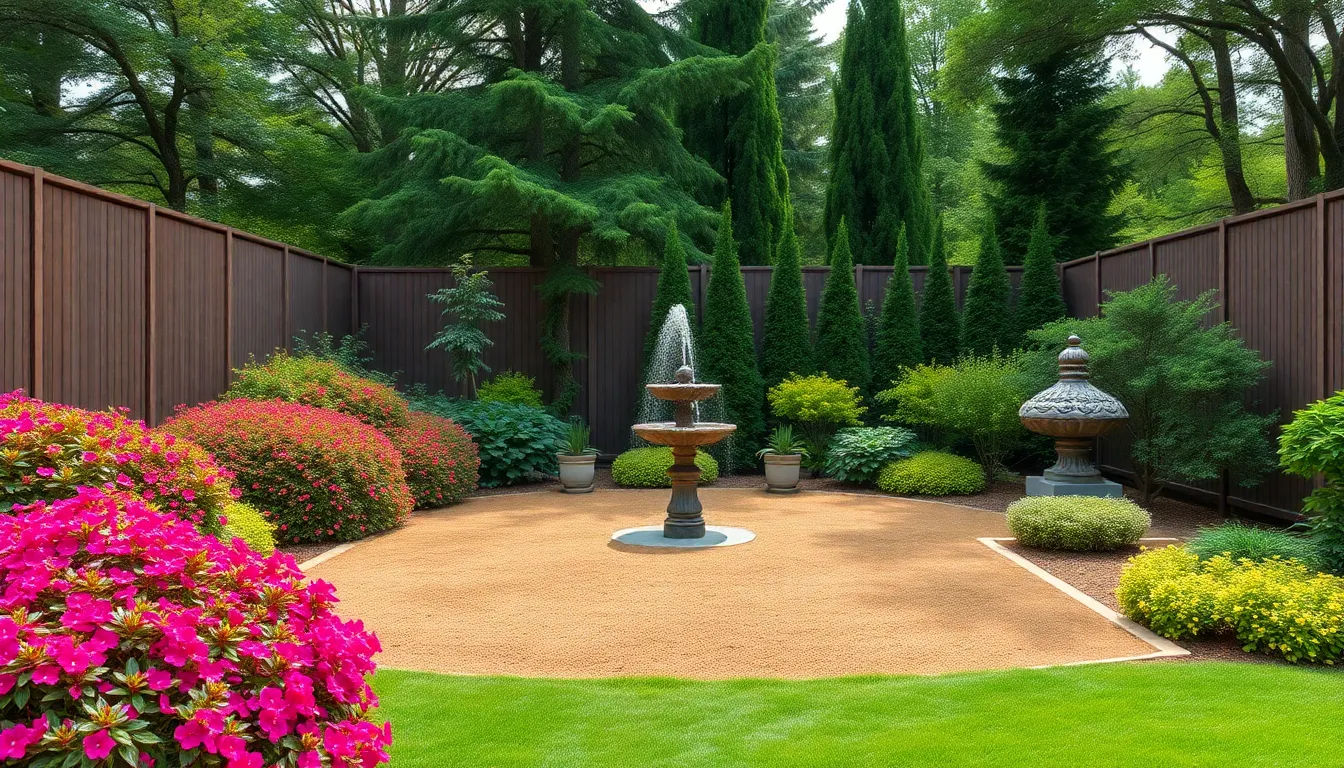
Transforming a corner of your garden into a yoga and stretching sanctuary creates the perfect space for mindful movement and peaceful reflection. We’ll guide you through essential elements that make outdoor yoga practice both comfortable and inspiring.
Create Level Ground With Proper Drainage
Building a stable foundation starts with creating perfectly level ground that supports safe yoga postures and stretching positions. We recommend installing a patio, deck, or compacted soil platform specifically designed to accommodate yoga mats and stretching exercises without wobbling or shifting.
Proper drainage becomes essential for maintaining a dry, usable space after rainfall and preventing water from pooling beneath your practice area. Grading soil away from your yoga zone ensures water flows naturally away from the platform, while installing dedicated drainage answers keeps the ground firm and comfortable year round.
Compacted surfaces work best when they’re slightly elevated above surrounding garden areas, allowing gravity to naturally direct moisture away from your practice space. Installing permeable materials like gravel or sand beneath your platform creates additional drainage layers that prevent water accumulation during heavy rains.
Add Privacy Screens and Wind Barriers
Creating visual barriers transforms your yoga space into a secluded retreat away from distractions and neighboring eyes. We suggest using natural plantings like tall shrubs, hydrangeas, and mature trees such as oaks or arborvitae to establish living privacy screens that grow more beautiful over time.
Constructed privacy elements offer immediate results when natural barriers need time to establish themselves. Pergolas with flowing curtains, bamboo panels, and decorative lattice screens create instant seclusion while adding architectural interest to your garden sanctuary.
Wind protection enhances comfort during outdoor practice by reducing air movement that can disrupt balance poses and meditation. Dense plantings serve double duty as both privacy screens and wind barriers, while solid structures like walls or tall fencing panels block strong gusts from disrupting your peaceful sessions.
Strategic placement of these barriers considers prevailing wind patterns in your area, ensuring maximum protection during typical weather conditions. Combining natural and constructed elements creates the most effective wind reduction while maintaining an organic garden aesthetic.
Incorporate Natural Elements for Ambiance
Natural elements significantly enhance the sensory experience of your outdoor yoga sanctuary through carefully chosen plants, materials, and features. We recommend selecting flowering shrubs and trees that provide gentle color palettes and subtle fragrances without overwhelming the peaceful atmosphere you’re creating.
Water features add soothing background sounds that mask neighborhood noise while promoting deeper relaxation during meditation and stretching sessions. Small fountains, gentle streams, or even simple water bowls create calming auditory elements that enhance your practice without requiring complex installation.
Natural flooring materials like wood decking or stone platforms blend seamlessly with garden surroundings while providing the stable surface your yoga practice demands. These materials age gracefully and develop character over time, becoming more beautiful as they weather naturally in your outdoor environment.
Soft landscaping elements frame your practice area with living beauty that changes throughout the seasons. Gentle color schemes using plants with varying textures and heights create visual interest while maintaining the serene atmosphere essential for mindful movement.
Install a Swimming Pool or Spa Area
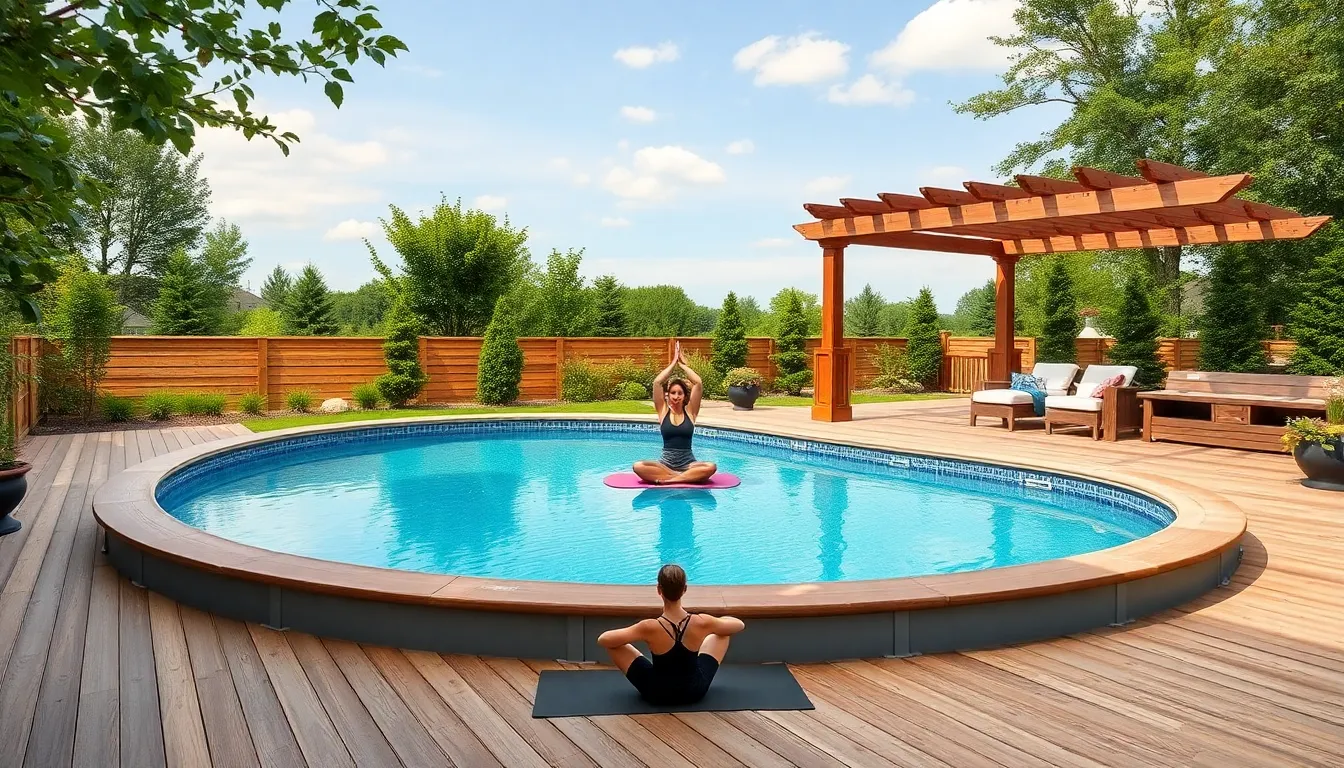
Adding water features to our garden gym creates the perfect blend of fitness and recovery. Swimming pools and spas transform ordinary backyard spaces into comprehensive wellness centers that support both cardiovascular training and muscle recovery.
Consider Above-Ground Pool Options
Above-ground pools offer a budget-friendly alternative to traditional in-ground installations for our garden gym projects. Installation costs typically range from $3,000 to $15,000 compared to $35,000 to $65,000 for in-ground pools, making them accessible for most homeowners.
Flexibility becomes a major advantage when choosing above-ground options. We can relocate these pools if our garden layout changes or remove them entirely without permanent industry damage. Round pools ranging from 12 to 33 feet in diameter work well for lap swimming and water aerobics.
Oval-shaped pools provide better swimming lane functionality for serious fitness enthusiasts. Models measuring 15×30 feet or 18×33 feet offer adequate space for stroke training and resistance exercises. Saltwater systems can be added to any above-ground pool to reduce chemical maintenance and create gentler water for daily workouts.
Design Surrounding Deck Spaces
Deck areas around our pool become essential extensions of the workout space. We should plan for a minimum 4-foot walkway around the entire perimeter to ensure safe movement and equipment access. Composite decking materials resist moisture and temperature changes better than traditional wood options.
Multi-level decking creates distinct zones for different activities. Raised sections can house outdoor fitness equipment like resistance bands anchor points and stretching areas. Lower levels near the water work perfectly for poolside yoga sessions and cool-down stretches.
Storage integration within deck design keeps pool maintenance equipment and workout gear organized. Built-in benches with lift-up seats provide seating and hidden storage for pool chemicals, cleaning tools, and exercise accessories. Pergolas or shade structures over portions of the deck extend usable hours during peak sun periods.
Plan for Year-Round Usage Answers
Pool covers become essential investments for extending our swimming season beyond traditional summer months. Solar covers can raise water temperatures by 10-15 degrees while reducing evaporation by up to 95%. Automatic cover systems provide convenience and better insulation for serious year-round swimmers.
Heating systems transform seasonal pools into four-season fitness facilities. Heat pumps work efficiently in temperatures above 45°F and cost approximately $2,500 to $4,500 to install. Solar heating systems offer eco-friendly alternatives that can maintain comfortable water temperatures from early spring through late fall.
Windscreens and privacy panels protect our pool area from harsh weather while maintaining usability. Retractable enclosures allow us to create semi-indoor swimming environments during colder months. Pool lighting extends evening workout sessions and creates attractive ambiance for nighttime relaxation and recovery sessions.
Set Up an Outdoor Boxing and Martial Arts Space
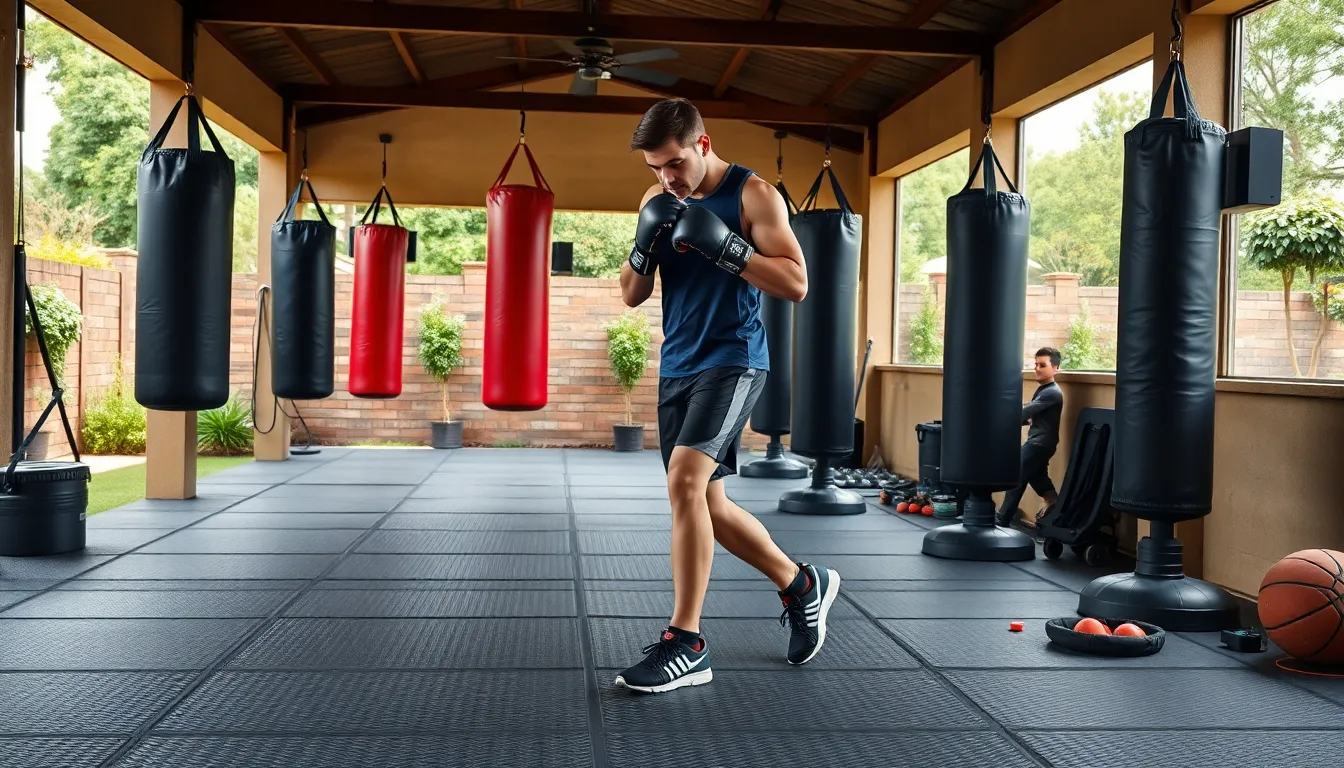
We’ll design a spacious garden area that accommodates ever-changing movement patterns essential for boxing and martial arts training. This dedicated space allows us to practice footwork, strikes, and comprehensive drills while maintaining complete safety throughout our workout routines.
Install Heavy Bags and Speed Bags
Heavy bags become the cornerstone equipment for developing power and building endurance in our outdoor training setup. We position these weatherproof bags securely using strong mounting frames or ceiling installations within covered areas to ensure maximum stability during intense sessions. Speed bags complement our heavy bag training by improving hand-eye coordination and developing consistent rhythm patterns that enhance our overall boxing technique.
Quality outdoor equipment withstands environmental conditions while delivering professional-grade performance for years of reliable use. We choose durable materials specifically designed for exterior applications, ensuring our investment remains protected against rain, sun, and temperature fluctuations. Proper positioning requires adequate clearance space around each bag, allowing us to move freely without obstruction during combination sequences.
Create Safe Flooring for Impact Training
Rubber gym tiles provide essential cushioning that protects our joints during high-impact movements like kicks, jumps, and defensive maneuvers. We install these impact-absorbing surfaces to create a stable foundation that prevents injuries while maintaining optimal traction for quick directional changes. Non-slip materials ensure consistent performance regardless of weather conditions, making our training space usable throughout different seasons.
Temporary flooring options offer flexibility for multipurpose garden use, while permanent installations deliver enhanced stability for serious training commitments. We select materials that support heavy equipment weight while providing adequate shock absorption for ground-based exercises. Proper drainage considerations prevent water accumulation that could compromise safety or damage our flooring investment.
Add Mirrors and Training Accessories
Mirrors enable real-time form monitoring that improves our technique development and helps identify areas needing refinement. We install outdoor-safe reflective surfaces within sheltered zones to protect them from weather damage while maintaining clear visibility during training sessions. Strategic mirror placement allows us to observe our movements from multiple angles, improving our self-correction abilities.
Essential accessories include resistance bands, boxing gloves, focus mitts, and interval timers that expand our training possibilities beyond basic striking practice. We organize these tools using wall-mounted hooks, storage racks, and weatherproof containers that keep everything accessible yet protected from outdoor elements. Quality storage answers maintain our equipment’s condition while ensuring quick setup for spontaneous training sessions.
Build a Rock Climbing or Bouldering Wall

We’re taking our garden gym to vertical heights with a custom climbing wall that delivers year-round adventure right outside our door. This addition transforms any outdoor space into a challenging training ground for climbers of all skill levels.
Design Height and Difficulty Variations
Variable angles create diverse training opportunities by offering sections that range from beginner-friendly vertical surfaces to challenging overhangs that test advanced skills. Start with an 8-foot vertical section for newcomers, then progress to 12-foot walls with 15-degree overhangs for intermediate climbers.
Multiple route difficulty accommodates different skill levels by incorporating sections with varying hold density and spacing patterns. Design easier routes with holds spaced 18-24 inches apart, while advanced sections feature holds positioned 30+ inches apart for ever-changing movement training.
Adjustable wall angles maximize training variety by building modular sections that can be repositioned from 90-degree vertical to 45-degree overhangs. This flexibility allows us to modify difficulty as our climbing skills develop over time.
| Wall Configuration | Height Range | Angle Options | Skill Level |
|---|---|---|---|
| Beginner Section | 6-8 feet | 90° vertical | Entry level |
| Intermediate Zone | 10-12 feet | 90°-105° slight overhang | Developing |
| Advanced Area | 12-16 feet | 105°-135° steep overhang | Expert |
Ensure Proper Safety Padding Below
Thick crash pads provide essential fall protection by creating a 4-6 inch cushioned landing zone that extends at least 8 feet from the wall base. Position multiple interlocking pads to eliminate dangerous gaps where injuries commonly occur during falls.
Professional-grade foam delivers superior impact absorption through high-density materials specifically designed for climbing applications. Choose pads with firm top layers that prevent ankle rolling and softer bottom cores that absorb landing forces effectively.
Strategic pad placement covers fall zones by mapping potential landing areas for different route sections and overlap patterns. Extend padding 2-3 feet beyond the wall’s widest overhang to account for ever-changing falls and swinging movements.
Plan for Route Changes and Progression
Modular hold systems enable route modifications by using T-nuts and bolt-on holds that can be repositioned as climbing skills advance. Install T-nuts in a 6-inch grid pattern across the entire climbing surface for maximum route-setting flexibility.
Color-coded routes organize difficulty progression by assigning exact hold colors to different skill levels, making it easy to identify appropriate challenges. Use green holds for beginner routes, blue for intermediate, and red for advanced climbing sequences.
Seasonal route updates maintain training motivation by changing hold positions every 4-6 weeks to prevent muscle memory stagnation. Document successful route configurations with photos to recreate favorite climbing sequences when desired.
Progressive training sequences build climbing strength systematically by designing routes that target exact muscle groups and movement patterns. Create endurance routes with 20+ moves for stamina building and power routes with explosive movements for strength development.
Create Storage Solutions for Equipment Management
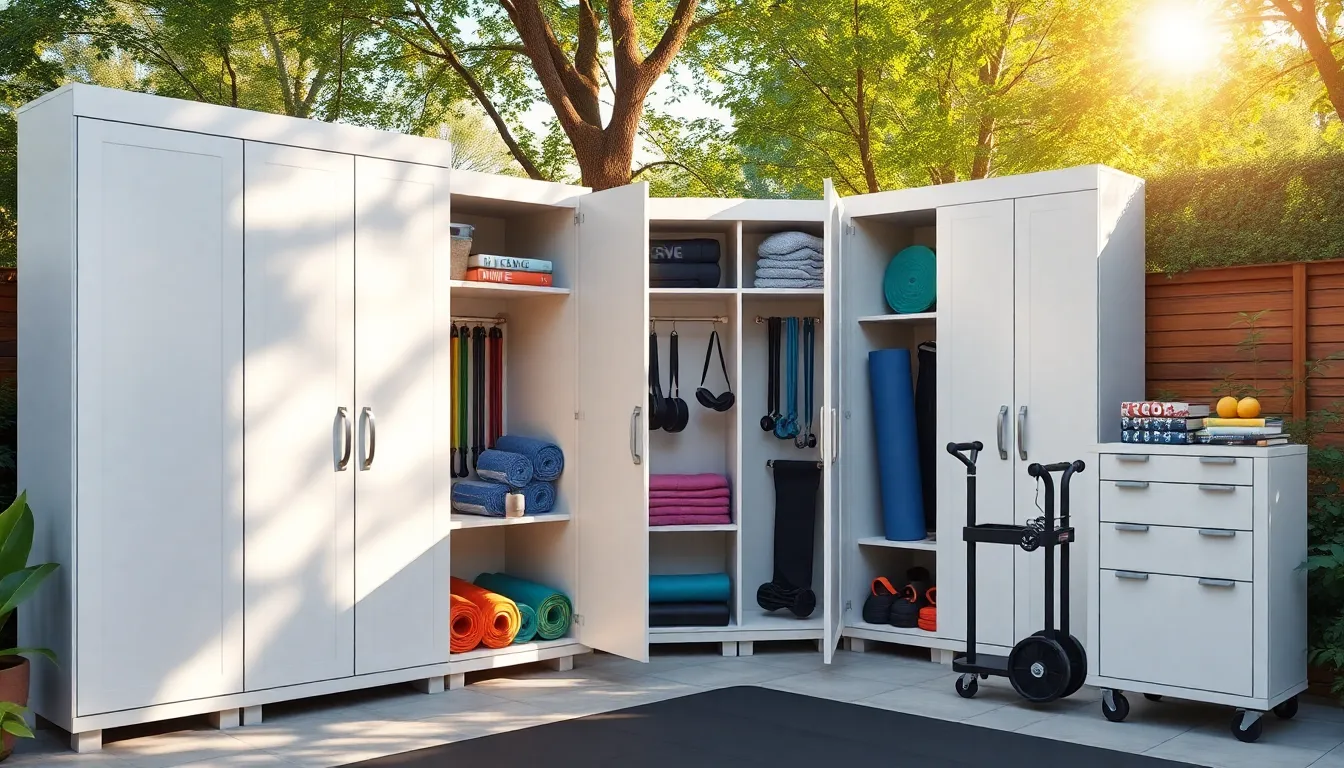
Smart storage transforms our garden gym from cluttered chaos into an organized training sanctuary. We need strategic answers that protect equipment while maintaining easy access for seamless workouts.
Build Weather-Resistant Storage Cabinets
Weather-resistant cabinets protect our valuable equipment from rain, snow, and UV damage throughout the year. Treated wood, metal with rust-proof coatings, and heavy-duty plastic materials ensure cabinet longevity against harsh outdoor conditions. European-manufactured outdoor fitness storage answers offer standalone or rack-integrated options that blend seamlessly with our garden gym aesthetic.
Wall-mounted cabinets maximize floor space while keeping smaller items like resistance bands, yoga blocks, and fitness accessories within easy reach. Floor-standing models accommodate larger equipment such as kettlebells, dumbbells, and foam rollers while maintaining weatherproof protection. Custom-fitted interior shelving and dividers organize gear efficiently and prevent damage from items shifting during storage.
Lockable mechanisms provide security for expensive equipment while ventilation features prevent moisture buildup that leads to rust and mildew. Strategic cabinet placement near our most-used workout zones reduces setup time and keeps training sessions flowing smoothly.
Design Mobile Equipment Carts
Mobile equipment carts revolutionize our garden gym flexibility by allowing quick relocation of gear to different training zones. Sturdy construction with weather-resistant materials ensures these carts withstand outdoor conditions while maintaining smooth mobility across various surfaces.
Heavy-duty wheels designed for outdoor terrain navigate grass, gravel, and paved areas without struggle or equipment damage. Multi-tiered cart designs accommodate different equipment sizes, from yoga mats and towels on upper shelves to heavier weights and accessories below. Custom-built options can be customized specifically for our unique equipment collection and garden layout.
Quick-release mechanisms and fold-down sides make loading and unloading equipment effortless during workout transitions. Integrated storage compartments keep small accessories organized and prevent loss during transport between training areas.
Organize Seasonal Gear Rotation Systems
Seasonal rotation systems keep our garden gym equipment relevant and functional throughout changing weather patterns. Storage zones labeled by season or workout type streamline gear selection and prevent equipment deterioration during off-seasons.
Garden sheds serve dual purposes as both storage facilities and training spaces, allowing complete gear swaps based on seasonal fitness goals. Container gyms provide weatherproof protection for equipment while offering additional workout space when conditions permit. Clear labeling systems and inventory lists track equipment location and condition during rotation cycles.
Climate-controlled storage areas protect sensitive equipment like electronics and leather accessories from extreme temperatures and humidity. Strategic rotation scheduling ensures equipment remains accessible when needed while extending overall lifespan through proper seasonal storage practices.
Plan for Year-Round Weather Protection

Maintaining our garden gym throughout changing seasons requires strategic weather protection systems. Smart planning ensures consistent access to our outdoor fitness space regardless of rain, snow, or extreme temperatures.
Install Retractable Awnings and Covers
Retractable awnings transform any garden gym into a versatile weather-protected zone. These adaptable systems provide essential shade during scorching summer days while offering complete rain protection when storms approach. We can position motorized awnings above weightlifting areas, yoga spaces, or cardio zones to create instant shelter at the touch of a button.
Waterproof canopy systems extend our workout seasons significantly. Fixed covers work exceptionally well over permanent structures like pull-up stations or boxing areas. Materials like heavy-duty vinyl or marine-grade fabric withstand wind speeds up to 55 mph while maintaining UV protection ratings of SPF 50+.
Pergola-style covers with retractable fabric panels offer the perfect balance of protection and openness. These semi-permanent structures integrate beautifully with garden landscaping while providing adjustable coverage. We can easily retract panels during pleasant weather to maintain that outdoor workout feeling.
Add Heating Options for Cold Seasons
Radiant floor heating systems keep our garden gym comfortable during winter months. Installing electric or hydronic heating beneath rubber flooring creates consistent warmth from the ground up. These systems maintain surface temperatures between 75-85°F even when outdoor temperatures drop below freezing.
Infrared heating units provide targeted warmth without consuming excessive energy. Wall-mounted infrared heaters warm objects and people directly rather than heating air, making them 30% more efficient than traditional space heaters. We can position these units above workout areas to create comfortable zones while exercising.
Insulated garden room construction maintains stable indoor temperatures year-round. Adding R-15 insulation to walls and R-30 to ceilings creates a thermal barrier that reduces heating costs by up to 40%. Incorporating bifold doors enhances natural light while maintaining temperature control when closed.
Design Drainage and Water Management
Proper drainage systems prevent water accumulation that could damage equipment or create safety hazards. Installing French drains around the perimeter of our garden gym directs water away from workout areas. These systems handle rainfall rates up to 2 inches per hour while maintaining dry surfaces for safe exercise.
Permeable flooring materials allow water to flow through rather than pooling on surfaces. Interlocking drainage tiles with raised surfaces create channels that direct water away while providing stable footing. These systems reduce slip hazards by 85% compared to solid rubber surfaces during wet conditions.
Water-resistant equipment selection protects our fitness investment from moisture damage. Choosing galvanized steel frames, powder-coated finishes, and marine-grade materials ensures equipment withstands humidity levels above 80%. Elevated storage platforms keep smaller equipment 6 inches above ground level to prevent water contact during heavy rains.
Conclusion
Creating your own garden gym opens up endless possibilities for staying fit while enjoying the great outdoors. We’ve explored everything from converting existing sheds into year-round fitness studios to building specialized zones for weightlifting cardio yoga and even rock climbing.
The key to success lies in thoughtful planning and choosing weather-resistant equipment that’ll withstand the elements. Whether you’re working with a small patio or expansive lawn your outdoor space can become a personalized fitness haven that rivals any commercial gym.
Remember that proper storage answers and year-round weather protection will keep your investment safe and functional throughout every season. With the right setup you’ll have a 24/7 accessible workout space that combines the benefits of fresh air natural beauty and convenient home-based fitness training.
Frequently Asked Questions
What is a garden gym and why should I consider creating one?
A garden gym is a personal fitness space created in your backyard that eliminates the need for crowded commercial gyms. It offers 24/7 accessibility, cost savings on membership fees, and the ability to work out in fresh air and natural surroundings. You can customize it to your specific fitness needs and preferences.
Can I convert my existing shed into a fitness studio?
Yes, converting a shed into a fitness studio is an excellent year-round solution. Clear out unnecessary items, level the flooring with foam tiles or rubber mats, paint walls in light colors, install mirrors and proper ventilation, and add electrical outlets for lighting and equipment.
What equipment works best for outdoor weightlifting areas?
Choose weather-resistant equipment like galvanized steel pull-up frames, outdoor fitness benches made from durable materials, and wooden beam pull-up bars treated for weather resistance. Proper rubber mat flooring systems and multipurpose lifting platforms are essential for safety during heavy lifting.
How do I create a bodyweight training zone in my garden?
Install robust pull-up bars and suspension systems using weather-resistant materials. Create multi-level platforms for varied workout intensity and incorporate natural movement obstacles like logs and rocks to enhance balance and coordination training while supporting natural movement patterns.
What’s the best way to set up a cardio exercise area outdoors?
Position cardio equipment facing visually appealing garden features for motivation. Install weather protection canopies to shield equipment from elements and consider outdoor-rated entertainment systems. Ensure reliable power solutions for uninterrupted operation and equipment protection.
How can I create a peaceful yoga and stretching space?
Build stable, level ground with proper drainage for safe practice. Install privacy screens and wind barriers using natural plantings or constructed elements. Incorporate plants and water features to create a serene environment that enhances mindfulness and relaxation.
Are swimming pools practical for garden gyms?
Yes, above-ground pools offer a budget-friendly fitness and recovery option. Design surrounding deck spaces for safety and functionality, including storage solutions. Implement year-round usage strategies like pool covers, heating systems, and protective structures for different weather conditions.
What should I consider for an outdoor boxing training area?
Install heavy bags and speed bags using weatherproof materials and proper positioning. Create safe flooring with rubber gym tiles for joint protection during high-impact training. Add mirrors for technique monitoring and ensure adequate storage solutions for training accessories.
Can I build a climbing wall in my garden gym?
Yes, you can create a vertical training ground with adjustable wall angles and modular sections for different skill levels. Install thick crash pads for fall protection, use modular hold systems for route modifications, and plan for seasonal updates to maintain training motivation.
How do I protect my garden gym equipment from weather?
Use weather-resistant storage cabinets made from treated wood or rust-proof metal. Install wall-mounted and floor-standing options with lockable mechanisms and ventilation features. Consider mobile equipment carts and seasonal gear rotation systems to maintain equipment functionality year-round.
What weather protection options keep my garden gym usable all seasons?
Install retractable awnings and waterproof canopy systems for shade and rain protection. Add heating options like radiant floor heating or infrared units for colder months. Ensure proper drainage systems and select water-resistant equipment to prevent moisture damage.
